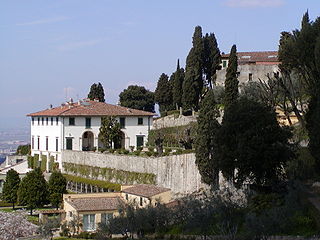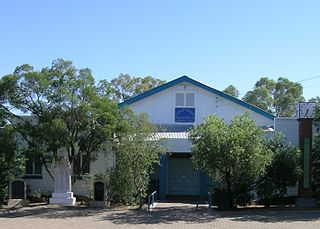
Bellevue Homestead is a heritage-listed homestead currently located in Coominya, Somerset Region, Queensland, Australia. It was built from c. 1872 to c. 1910. It was added to the Queensland Heritage Register on 21 October 1992.

Oak Lodge and Spreydon is a heritage-listed pair of villas at 7 Warra Street & 30 Rome Street, Newtown, Toowoomba, Toowoomba Region, Queensland, Australia. They were designed by architectural firm James Marks and Son and was built from 1890s to c. 1923. They were added to the Queensland Heritage Register on 1 October 2003.

Ascot House is a heritage-listed villa at 15 Newmarket Street, Newtown, Toowoomba, Toowoomba Region, Queensland, Australia. It was built from 1870s to 1890s. It was added to the Queensland Heritage Register on 21 October 1992.

Carlton House is a heritage-listed boarding house at 3 Mill Street, Toowoomba, Toowoomba Region, Queensland, Australia. It was built from c. 1875 to 1900s. It was added to the Queensland Heritage Register on 31 October 1994.

Clifford House is a heritage-listed club house at 120 Russell Street, Toowoomba, Toowoomba Region, Queensland, Australia. It was built c. 1865. It was added to the Queensland Heritage Register on 21 October 1992.

Redlands is a heritage-listed villa at 154 Stephen Street, Toowoomba, Toowoomba Region, Queensland, Australia. It was designed by architect James Marks and built from 1889 to c. 1930. It is also known as Concordia College Administration Centre. It was added to the Queensland Heritage Register on 21 October 1992.
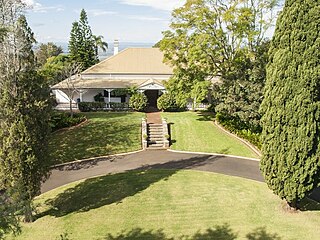
Fernside is a heritage-listed villa at 4-6 Fernside Street, East Toowoomba, Toowoomba, Toowoomba Region, Queensland, Australia. It was built from c. 1876 to c. 1915. It was added to the Queensland Heritage Register on 21 October 1992.

Gabbinbar is a heritage-listed villa at 344-376 Ramsay Street, Toowoomba, Toowoomba Region, Queensland, Australia. It was designed by architect Willoughby Powell for the Rev. Dr. William Lambie Nelson and built in 1876 by Richard Godsall. It was added to the Queensland Heritage Register on 21 October 1992.

Gladstone House and Cottage is a heritage-listed detached house at 1B-3 Gladstone Street, Newtown, Toowoomba, Toowoomba Region, Queensland, Australia. It was designed by Harry Marks for himself and built c. 1908. It is also known as St Rest. It was added to the Queensland Heritage Register on 13 January 1995.

Tor is a heritage-listed villa at 396 Tor Street, Newtown, Toowoomba, Toowoomba Region, Queensland, Australia. It was designed by William Hodgen and built in 1904. It was added to the Queensland Heritage Register on 28 May 1999.
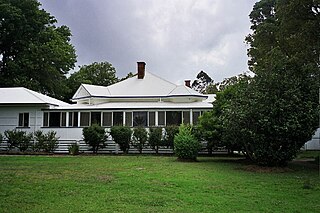
Unara is a heritage-listed detached house at 9-13 Tourist Road, East Toowoomba, Toowoomba, Toowoomba Region, Queensland, Australia. It was built c. 1906. It is also known as Unara Community Health Centre. It was added to the Queensland Heritage Register on 24 March 2000.

Weetwood is a heritage-listed villa at 427 Tor Street, Newtown, Toowoomba, Toowoomba Region, Queensland, Australia. It was designed by architect James Marks and built from 1888 onwards. It was added to the Queensland Heritage Register on 21 October 1992.

The White Horse Hotel is a heritage-listed former hotel at 456 Ruthven Street, Toowoomba, Queensland, Australia. A hotel known as the White Horse Hotel is known to have existed since 1866. The current two-storey building was built in stages, with much of the current fabric dating from renovations c. 1912, which included a new facade and the remodelling of both wings. The verandah overlooking Ruthven Street had been removed by 1978, and an additional room was built about this time.

Whyembah is a heritage-listed detached house at 80 Campbell Street, East Toowoomba, Toowoomba, Toowoomba Region, Queensland, Australia. It was built c. 1896, and renovated and enlarged in 1906. It is sometimes spelled differently, e.g. Wyembar.

The Michael Gannon residence is a heritage-listed holiday home at 150 Kingsley Terrace, Manly, City of Brisbane, Queensland, Australia. It was built c. 1888. It was added to the Queensland Heritage Register on 27 October 2000.

Franklyn Vale Homestead is a heritage-listed homestead at Franklin Vale Road, Mount Mort, City of Ipswich, Queensland, Australia. It was built in the early 1870s. It was added to the Queensland Heritage Register on 21 October 1992.

The Wright Family Houses area heritage-listed group of detached houses at 98/100/106 Mt Crosby Road, Tivoli, City of Ipswich, Queensland, Australia. It was built from c. 1898 onwards. No. 100 is also known as Oaklands and No. 106 is also known as Wrightlands. It was added to the Queensland Heritage Register on 30 January 2004.
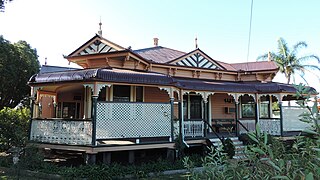
Aberfoyle is a heritage-listed detached house at 35 Wood Street, Warwick, Southern Downs Region, Queensland, Australia. It was designed by architect Hugh Hamilton Campbell and built from 1910 to c. 1927. It was added to the Queensland Heritage Register on 5 August 1996. It is also listed on the Southern Downs Local Heritage Register.
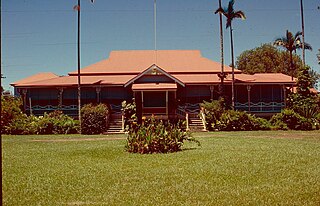
Greenmount Homestead is a heritage-listed homestead at Greenmount Road, Walkerston, Mackay Region, Queensland, Australia. It was designed by William Sykes and built in 1915 by Arthur Carter & Co. It was added to the Queensland Heritage Register on 6 September 1993.

Boondooma Homestead is a heritage-listed homestead at Mundubbera - Durong Road, Boondooma, South Burnett Region, Queensland, Australia. It was built from the 1850s to the 1870s. It was added to the Queensland Heritage Register on 21 October 1992.

